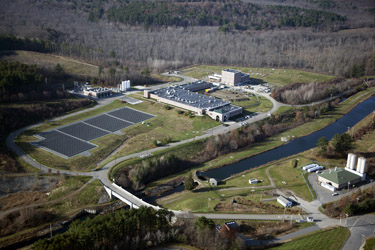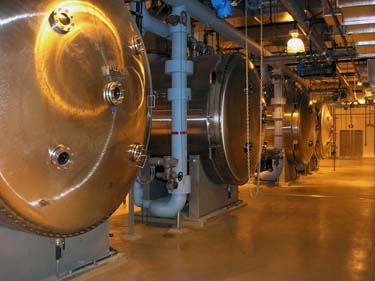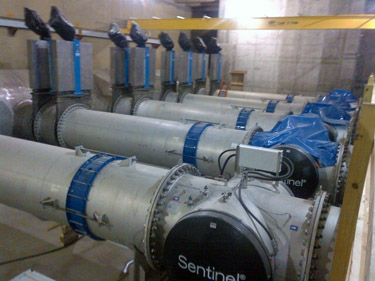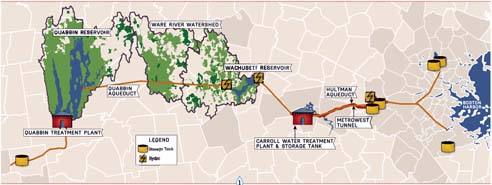| Home |
| About MWRA |
| Water System |
| Sewer System |
| Harbor and Bay |
| School Program |
| Doing Business with MWRA |
| Contact MWRA |
The John J. Carroll Water Treatment Plant
Massachusetts Water Resources Authority
Since July 2005, metropolitan Boston’s water supply has been treated at the John J. Carroll Water Treatment Plant (CWTP) in Marlborough, Massachusetts.
The plant is part of MWRA's Integrated Water Supply Improvement Program.
How Drinking Water is Treated at the Carroll Plant
Since 2005, the Carroll Water Treatment Plant has used ozone as a primary disinfectant. Ozone consists of three atoms of oxygen. It is created by applying an electrical current to pure oxygen in a specially designed stainless steel chamber.
Ozone provides better disinfection than chlorine alone. It also reduces the amount of potentially harmful disinfection by-products. Since the plant has been on-line, it has exceeded current regulatory requirements for inactivation of Giardia, provided
Cryptosporidium inactivation in advance of future regulations and reduced the formation of disinfection by-products.
The plant has four Fuji ozone generators designed to treat 275 million gallons of water on an average day, and a peak level of 405 million gallons per day. Since the plant was built, demand has declined to about 200 million gallons per day.
In April 2014, ultraviolet ("UV") light treatment was added in compliance with the EPA's Long-Term 2 Enhanced Surface Water Treatment Rule, which required the addition of a second disinfection process.
UV light is essentially a more potent form of the natural disinfection from sunlight. UV enables MWRA to inactivate the most difficult to kill pathogens - which could potentially be in the source water - without the use of additional chemicals and any associated disinfection by-products. The UV process and MWRA’s high quality source water allows MWRA to meet new regulatory requirements cost effectively.
UV light damages the DNA of bacteria, viruses and other pathogens, making it a strong disinfectant. UV light also inactivates chemically resistant parasites such as Cryptosporidium and Giardia.
The use of UV for Cryptosporidium inactivation will also allow MWRA to lower the ozone dose, thus reducing electricity usage and offsetting much of the electrical use of the new UV facilities. Ozone will continue to increase the clarity of the water, remove certain algae-related tastes and odors, and will remain as the first primary disinfectant with UV as the second.
A 500 kW photovoltaic array also provides the plant with solar electricity to help defray costs.
| Water Treatment Steps at the Carroll Water Treatment Plant | |||||||||||||||||||||||||||
|
Where the Water Treated at the Carroll Plant Comes From
MWRA’s source waters are the Quabbin Reservoir, about 65 miles west of Boston, and the Wachusett Reservoir, about 35 miles west of Boston. These reservoirs supply wholesale water to local water departments in 51 communities. The two reservoirs combined supplied about 200 million gallons a day of high quality water to consumers in 2011.
The Quabbin and Wachusett watersheds are protected naturally with over 85% of the watersheds covered in forest and wetlands.
To ensure safety, the streams and reservoirs are tested often and patrolled daily by the Department of Conservation and Recreation (DCR).
Communities Served by the Carroll Water Treatment Plant
Arlington, Ashland*, Bedford*, Belmont, Boston, Brookline, Burlington*, Cambridge**, Canton, Chelsea, Dedham*, Everett, Framingham, Lexington, Lynn GE*, Lynnfield, Malden, Marblehead, Marlborough*, Medford, Melrose, Milton, Nahant, Needham *, Newton, Northborough*, Norwood, Peabody*, Quincy, Reading, Revere, Saugus, Somerville, Southborough, Stoneham, Stoughton*, Swampscott, Waltham, Wakefield*, Watertown, Wellesley* Weston, Westwood*, Wilmington*, Winchester*, Winthrop, Woburn*. (Updated 05/03/21)
* Partially-supplied communities: receive some of their water from MWRA.
** Emergency-supply community: receives MWRA water in emergencies.
About John J. Carroll
The plant was named after John J. Carroll, the only original member of the MWRA Board of Directors still serving today. He was appointed in 1985 as a representative of the MWRA Advisory Board and currently serves as Vice Chairman.
Further Reading
MWRA's Integrated Water Quality Supply Program
Annual Water Quality Test Results
Updated May 3, 2021



